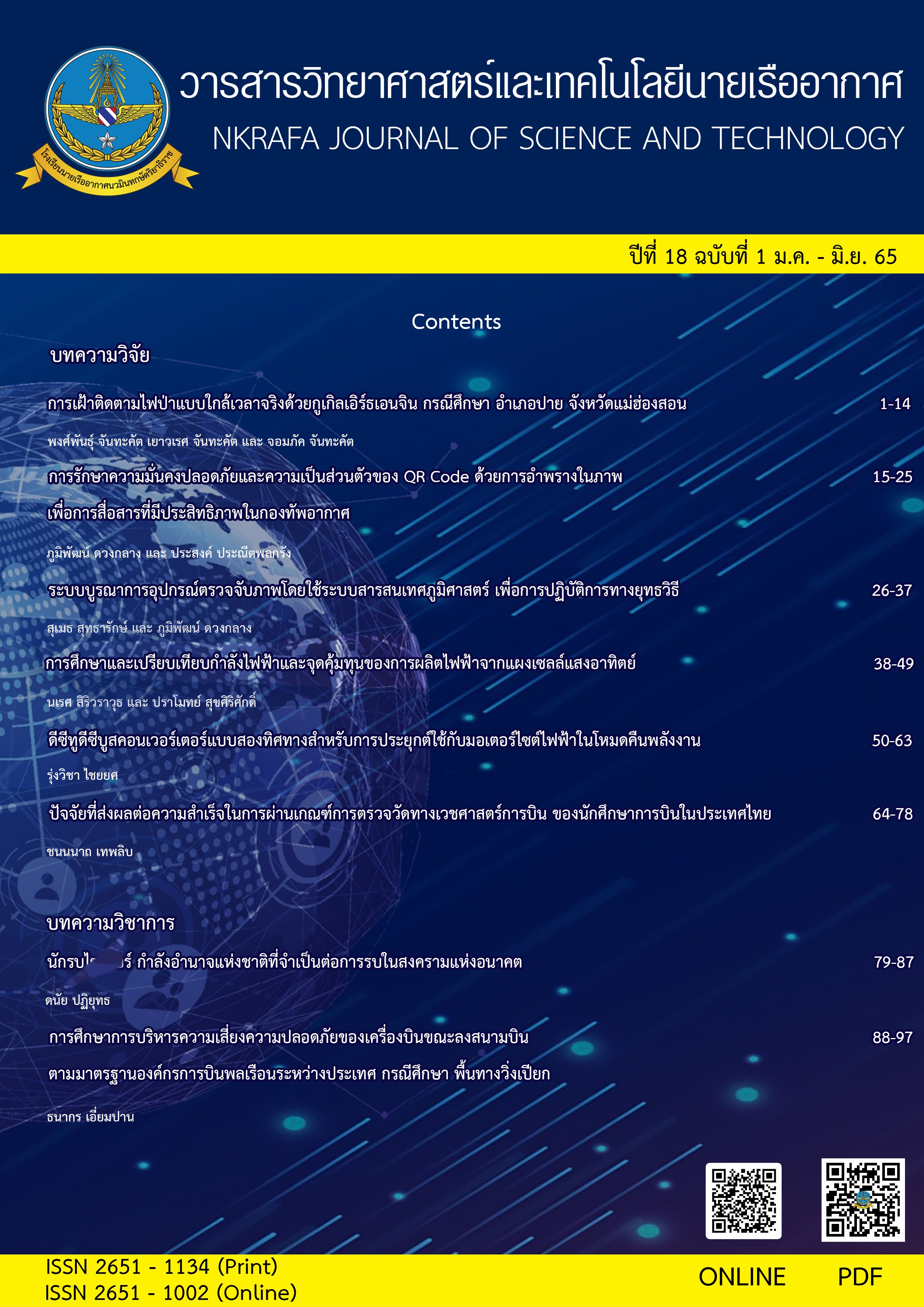The Study and Compare the Power and Break-even Point of Electricity Generation from Solar Panels
Main Article Content
Abstract
In the present, our world consumes a higher amount of electricity every year. To save electricity, humans therefore find alternative sources of energy for renewable energy to reduce the use of electricity. One of the popular alternatives is solar energy as it is a clean energy that does not pollute the environment. The researchers therefore conducted a study that found that when the solar panel works for a long time, it generates heat which causes its efficiency to decrease. Therefore, researchers designed a cooling system for solar panels. The test used a 330 watt solar panel consisting of 3 types: normal, air-cooled, and water-cooled. It was found that air-cooled solar panels produced the highest average power output at 1.43 units per day, followed by water-cooled and conventional systems at 1.41 and 1.33 units per day, respectively. If considering the normal power generation of solar panels as criteria, it was found that air cooling can increase power generation by 7.52%, and water cooling can increase power generation by 6.02%. Break-even point calculations show that conventional solar panels pay back faster. The best at 4.57 years, followed by a solar panel with a water cooling system and air cooling system at 4.60 years and 6.02 years, respectively.
Article Details

This work is licensed under a Creative Commons Attribution-NonCommercial-NoDerivatives 4.0 International License.
- Content and information in articles published in NKRAFA Journal of Science and Technology are comment and responsibility of authors of articles directly. Journal editorial do no need to agree or share any responsibility.
- NKRAFA Journal of Science and Technology Articles holds the copyright of the content, pictures, images etc. which published in it. If any person or agency require to reuse all or some part of articles, the permission must be obtained from the NKRAFA Journal of Science and Technology.
References
กรมพัฒนาพลังงานทดแทนและอนุรักษ์พลังงาน. (2557). พลังงานแสงอาทิตย์กับประเทศไทย. สืบค้น 15 มกราคม 2565, จาก https://ienergyguru.com/2015/07/solar-resource-map-of-thailand/
สำนักงานสภาการเศรษฐกิจและสังคมแห่งชาติ. (2563). ยุทธศาสตร์ชาติ 20 ปี. สืบค้น 15 มกราคม 2565 จาก http://nscr.nesdc.go.th/ยุทธศาสตร์ชาติ
Arno, S., Klaus, J., Olindo, I., Rene, V.S., & Miro, Z. (2016). Solar Energy. Cambridge: UIT Cambridge Ltd.
Christopher, L. (2008). Fundamental Electrical and Electronic Principles. Oxford: Taylor & Francis Ltd.
การไฟฟ้านครหลวง. (2565). การคิดค่าไฟฟ้าแบบต่าง ๆ .สืบค้น 15 มกราคม 2565 จาก
https://www.mea.or.th/aboutelectric/116/280/form/11
Mehmet, E.M., & Fukan, D. (2011). A Review of the Factors Affecting Operation and Efficiency of Photovoltaic Based Electricity Generation Systems. Renewable and Sustainable Energy Reviews. 15(5): 2176-2184.
Nuchida, S. & Prapapit, B. (2014). The Investigation of Produced Power Output During High Operating Temperature Occurrences of Monocrystalline and Amorphous Photovoltaic Modules. Energy Procedia. 52(1), 459-465.
Nuchida, S., Chhaina, S., Veekit R., & Piyachat, S. (2015). Effect of Temperature Reduction on Produced Power Performance of Solar Panels. The 6th TSME International Conference on Mechanical Engineering (1216-1219). Bangkok: Thailand.
Moharram, K.A., Abd-ElHady, M.S., Kandil, H.A., & El-Sherif, H. (2013). Enhancing the Performance of Photovoltaic Panals by Water Cooling. Ain Shams Engineering Journal. 4(1):869-877.
อนุรัตน์ เทวตา และ ยุธนา ศรีอุดม. (2561). การศึกษาเชิงทดลองการเพิ่มประสิทธิภาพแผงเซลล์แสงอาทิตย์โดยใช้ท่อความร้อนแบบแบน. วารสารวิชาการและวิจัย มทร.พระนคร, 6(1): 83-94.
สมชาติ บุญศรี. สุพิชัย แสงสุวรรณ และ อิทธิพล หินดี. (2560). การศึกษาเทคนิคการลดอุณหภูมิของแผงเซลล์แสงอาทิตย์โดยระบบระบายความร้อนของน้ำที่แตกต่างกัน. ในการประชุมวิชาการระดับชาติสถาบันวิชาการและวิจัย มหาวิทยาลัยราชภัฏกำแพงเพชร ครั้งที่ 4 (391-399). กำแพงเพชร: มหาวิทยาลัยราชภัฏกำแพงเพชร.
พศวีร์ ศรีโหมด. เติมพงษ์ ศรีเทศ. วิชชากร เฮงศรีธวัช และ พงศกร เจริญสุข. (2553). การศึกษาการเพิ่มสมรรถนะแผงเซลล์แสงอาทิตย์. ในการประชุมวิชาการวิศวกรรมไฟฟ้า มหาวิทยาลัยนเรศวร ครั้งที่ 43 (541-544). พิษณุโลก: มหาวิทยาลัยนเรศวร.
กรมพัฒนาพลังงานทดแทนและอนุรักษ์พลังงาน. (2562). การผลิตไฟฟ้าจากพลังงานแสงอาทิตย์. สืบค้น 27 มกราคม 2565, จาก https://webkc.dede.go.th/testmax/sides/default/files/


